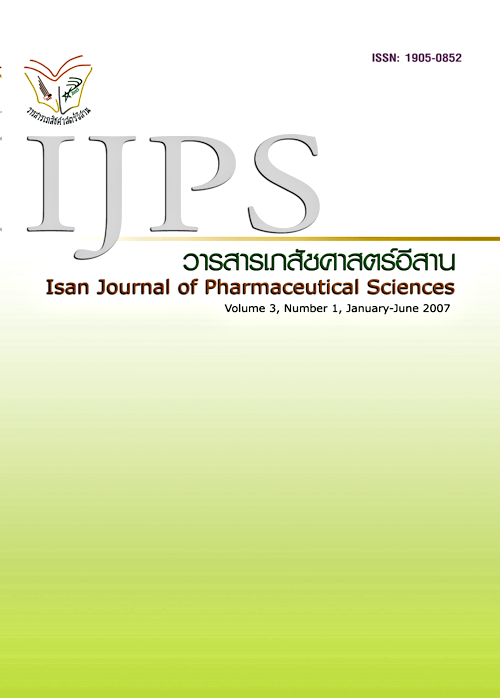Comparative Basic Pharmacognostic Studies of Three Murdanniaspecies (Family Commelinaceae)Surasit Yaodoung
Main Article Content
Abstract
The comparative basic pharmacognostic studies for three Murdanniaspecies (Family Commelinaceae), M. bracteata, M. loriformisand M. nudiflora, were conducted by using methods of diagnostic microscopic studies (leaf scraping and leaf clearing) and phytochemical methods (physico-chemical value and thin-layer chromatography). Cutin pattern and macro-hairs are distinguished epidermal microscopic characters among the species. The differences of total phenolic contents and thin-layer chromatogram are supported the identification.
Article Details
In the case that some parts are used by others The author must Confirm that obtaining permission to use some of the original authors. And must attach evidence That the permission has been included
References
Faden RB, Inman KE. 1996. Leaf Anatomy ofthe African Genera Commelinaceae. In:Anthericopsis and Murdannia. TheBiodiversity of African Plants. KluwerAcademic Publishers, Netherland.pp 464-471.
Folin O, Ciocalteu V. 1927. On Tyrosine andTryptophane Determination in Proteins.J Biol Chem 27: 627-650.
Intiyot Y, Kinouchi T, Kataoka K, et al., 2002.Antimutagenicity of Murdannia loriformisin the Salmonella Mutation Assay andits Inhibitory Effects on Azoxymethane-induced DNA Methylation and Aberrantcrypt Focus Formation in Male F344Rats. J Med Investigation 49(1-2): 25-34.
Intiyot Y, Kinouchi T, Vinitketkumnuen U, et al.,1998. Effect of Murnannia loriformisExtract on Xenobiotic Metabolizing EnzymeIntroduction and AOM-Induced ColonCancer in Rats. The 3rd InternationalConference on Environmental Mutagensin Human Populations. Bangkok, Thailand.pp116.Jain SK, De Filipps RA. 1991. Medicinal Plantsof India. Vol. I. Reference Publications,Algonac, Michigan, USA. pp249-251.
Jiratchariyakul W, Mongkarndi P, Okabe H,et al., 1998. Cytotoxic Glycosphingolipidfrom Murdannia loriformis (Hassk.)Rolla Rao & Kammathy. Thai Journalof Pharmaceutical Sciences 5(20):10-20.
Jirawongse VA. 2000. Thai Herbal Pharma-copoeia. Vol. II. Prachachon co., Ltd.,Bangkok, Thailand. pp4.
Perry LM, Metzger J. 1980. Medicinal Plantsof East and Southeast Asia: AttributedProperties and Uses. The MIT PressCambridge, Massacahusetts, London,England. pp 82.
Phetsuk P, Hahnvajanawong C, Lulitanond V,et al., 2005. Immunomodulatory Effectof Thai Plant [Master of Science Thesisin Medical Microbiology]. Khon Kaen,The Graduate School, Khon KaenUniversity. (abstract)
Saralamp P, Chuakul W, Temsiririrkkul R, et al.,1996. Medicinal Plants in Thailand. Vol. I.Amarin Printing and Publishing PublicCo..Ltd. Bangkok,Thailand. pp 162.
Thitimetharoch T, Chantaranothai P, Thamma-thaworn A, Faden RB. 2004. TaxonomicStudies of the Family Commelinaceaein Thailand. [Ph.D. Philosophy Thesis inBiology]. Khon Kaen, The Graduate School,Khon Kaen University. pp 75-190.
Tomlinson PB. 1969. Anatomy of theMonocotyledons III (Commelinales-Zingiberales). The Clarendon Press, Oxford.pp 371-395.
Vinitketkumnuen U, CharoenkunathumW, Kongtawelert P, et al., 1996. Antimutagenicity and DT-diaphoraseInducer Activity of Thai Medicinal Plant,Murdannia loriformis. Herbs SpicesMedicinal Plants 4: 45-52.
Vinitketkumnuen U, Chewonarin T, DhumtanomP. et al., 1999. Aflatoxinalbumin AdductsFormation after Single and Multiple Doseof Alflatoxin B1 in Rats Treated withThai Medicinal Plants. Mutation Research428: 345-51.
Wagner H, Bladt S, Zgainski EM. 1984.Plant Drug Analysis. Springer-Verlag,New York, USA. pp 349-354.


